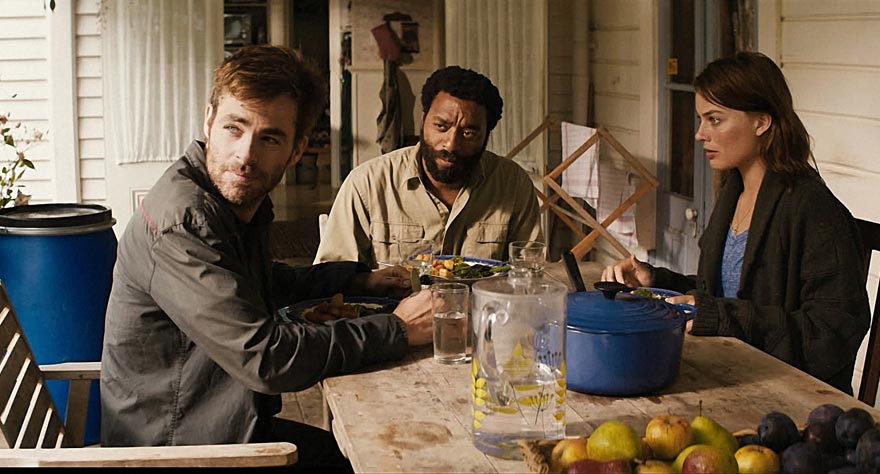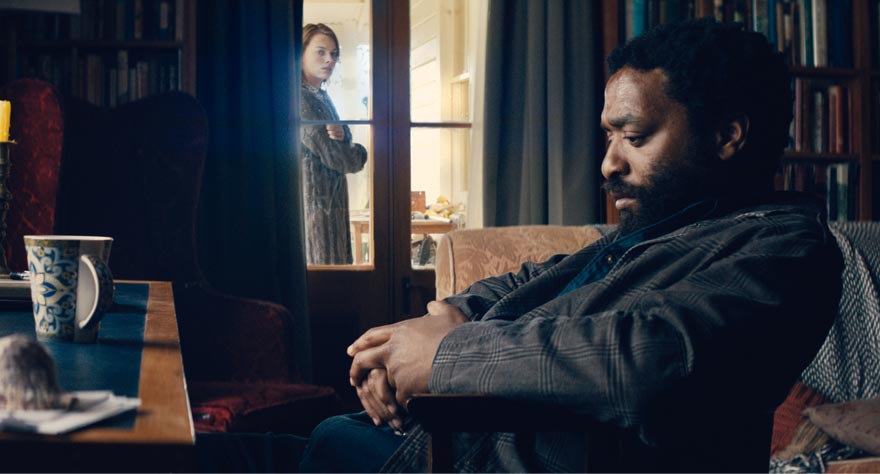
This tense psychological dystopian thriller doesn't have your average 'Hunger Games' love triangle.

This tense psychological dystopian thriller doesn't have your average 'Hunger Games' love triangle.
The allure of a dystopian-set film usually seems to lie in its many opportunities for action, cutthroat survival, zombies/talking monkeys/other evolutionary developments, and the always popular spectacle of seeing well-known cultural landmarks in ruin. I will admit that’s not why I keep coming back for them. I’m a junkie for relational dynamics in extreme duress and social psychology experimentation isn’t a career path I’m all that cut out for, so apocalyptic films it is.
Judging by its poster—which mostly consists of the faces of Chiwetel Ejiofor, Margot Robbie, and Chris Pine in blue-tinted, love-triangle infused expressions of seriousness–it’s easy not to pick up on the genre of Z For Zachariah. With nary an upturned Statue of Liberty, decaying zombie, or even a single action scene to speak of, it is actually post-apocalyptic. And while, yes, there is a love triangle at the center of the conflict, that these may just be the last three people on earth, that they are essentially strangers to one another, and that survival instincts turn people into manipulative creatures, all make for a nuanced psychological drama.
This is no Katniss, Peeta, Gale situation. Where Z For Zachariah excels is in its lack of outright drama. A lot like his 2012 film Compliance, Craig Zobel has fashioned another film where, when the credits roll, you realize you’d been holding your breath a great long while.
The film begins with Ann, played in an ambiguous state of early adulthood by Margot Robbie. Clad in a plastic suit with a portable oxygen tank, she searches for supplies and peruses books in the now dilapidated library. A few obligatory tableaus of dusty school rooms, empty grocery stores, etc. set the stage of the abandoned world Ann lives in. She makes her way home on a dirt road, removing her mask only once she’s gotten far enough away from the town. For whatever reason, the valley where her family farm, deep water well, and family church are all located is a safe place to breathe and live. And as a farm-raised girl, Ann has the know-how to stay alive despite being on her own.
Between Katniss and Ann, I’m starting to think the South may be the place to head in the case of impending worldwide destruction.
Ann’s contained and lonesome world expands considerably when she comes across a person in a hazmat suit. This scientist (Ejiofor) tests the air and plant life as Ann watches on in wonder. When he deems it safe, he rips off his suit, gulps the clean air and then rather over-exuberantly plunges into a nearby waterfall. Not realizing the water in this particular stream isn’t safe for jumping around in, Ann ends up having to nurse him back to health after he gets sick from radiation poisoning, taking him back to her farm to recoup.
Ann and the scientist named Loomis form a friendship, her demeanor one of sweet God-fearing Southerner, savvy in agricultural arts, he a science-fearing intrepid intellectual good at building. Once his strength returns he pitches in, helping Ann get farm equipment up and running and concocting a plan to utilize the waterfall to power the defunct generator. Ann is grateful, but overall more interested in there being another person alive in her world. Her family all left, apparently unsatisfied with sitting tight, feeling it their duty to search for survivors.
It doesn’t take long for Ann to try and use her unpracticed skills of seduction on Loomis. He admits to an attraction, but slows her down. After all they have forever to get to know one another uninterrupted, right? Enter an interruption. Covered in soot and a horrible haircut, Chris Pine’s Caleb appears. His familiarity with the area and good Christian manners immediately appeal to Ann’s sense of Southern hospitality. And with his charm, masculinity, and subtle passive aggression he becomes an instant threat to Loomis’s short-lived utopian fairytale.

Nissar Modi’s script, based on the novel by Robert C. O’Brien, doesn’t catapult into territorial insecurity or any form of violence, allowing a tentative and flimsy sort of trust to slowly build between the characters. Even as Loomis identifies that there is an obvious affinity forming between Ann and Caleb, his distrust lies within his inherent understanding of the way men behave in this new world. Ann has avoided some of the more psychologically disturbing aspects of what appears to be a nuclear holocaust, and Loomis has avoided telling her much of the outside world. When he tries to open up to her about this in order to prove his credulity toward Caleb, it only backfires by making her question what she knows of the man she thinks she loves.
Ejiofor plays Loomis’s descent from hopeful to threatened, capturing a primal and more subdued sort of survival mode. Survival against the possibility of threat in a world where one needs to be two steps ahead. As he and Caleb and Ann build the watermill that will ensure they survive the winter, Loomis and Caleb test each other, trying to decide what sort of threat the other is. Ann is relatively naive to the danger felt whenever Loomis and Caleb are onscreen together, but Robbie does a good job of conveying both Ann’s innocence to romantic entanglement and her skillful aptitude for survival. Caleb remains a mostly unexplored character, playing his role as the unknown quantity, the masked threat more frightening because of all he doesn’t say. Pine’s playful smile and knowing eyes perfectly convey the creepy seduction Caleb uses to woo Ann and to disarm Loomis.
The racial dynamics of the threesome isn’t overtly explored in any real depth, but Zobel does some diligence, such as a scene where Loomis gives Ann permission to “go be white people” together with Caleb. It’s funny, if not profound, and Ann’s innocent response of confusion doesn’t do much to continue the conversation. In the end the film sticks to themes around compatibility vs. attraction, religion vs. science, and the moral implications of following one’s instincts to circumvent a threat. The film’s climax is both tense and ambiguous, leaving a severe discomfort from its refusal to point to anything clear. But that’s another staple of any good dystopia: the paths aren’t clear and the compasses don’t work.